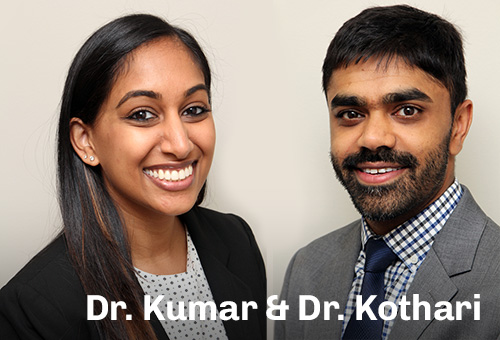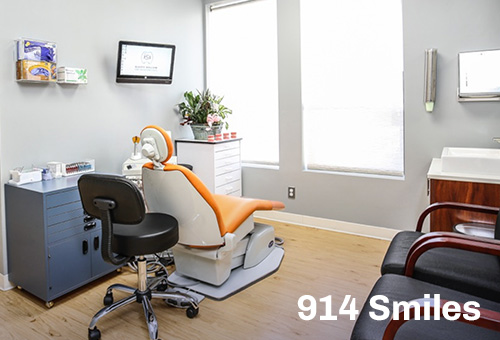
Having swollen or inflamed gums with braces can be startling. Is it simply gum irritation from your braces or is it a sign of gingivitis? Will it go away on its own or do you need to visit your dentist? Our Tarrytown orthodontist, Dr. Rishi Kothari, has the answers. In this post, we’ll be covering everything you need to know about braces and your gums.
Causes of Swollen Gums With Braces
Irritation
Braces can irritate your gums when you first get them put on. The brackets and wires may rub against the soft tissues of your mouth, causing some redness, swelling and discomfort. The good news is, your mouth will acclimate to your appliance and the soft tissues will “toughen up.”
Gum irritation from braces typically resolves itself within a few weeks. If the issue goes away once you’re used to wearing braces, then this is the most likely culprit.
Food Debris
Certain foods like popcorn hulls can easily get trapped in your brackets and wires, between your teeth and under your gumline, resulting in inflammation and pain. The swelling will go down once the food is removed.
Lack of Stimulation
Normally, whenever you chew food or brush the top of your teeth along your gums, the food or toothbrush massages the soft tissues. But once you get braces, the brackets and wires block this natural stimulation. Sometimes, the lack of stimulation leads to swollen gums. To prevent this, you can gently massage your gums with your toothbrush and make sure you’re brushing the part of your teeth between your braces and gumline thoroughly.
Gingival Enlargement
Having puffy, big gums with braces, or even experiencing your gums growing over your braces, may be a sign of gingival enlargement, also called hypertrophy or hyperplasia. This abnormal tissue growth can be due to certain medical conditions, medications or a rare hereditary condition.
Yet, most commonly, if your gums are growing over your braces, it’s an indication that you need to improve your oral hygiene. As bacteria and plaque build up, it causes inflammation and irritation of the gums, which, in some people, triggers the growth of more gum tissue. If improving your oral hygiene doesn’t alleviate the problem, talk with your orthodontist or general dentist.
Gum Disease
Excellent oral hygiene is the key to keeping your gums healthy with braces. However, your appliance adds a layer of complexity to removing bacteria and plaque. If plaque isn’t removed regularly, it increases your risk of gum disease (periodontal disease) and the swollen, inflamed gums that come along with it.
What is Gum Disease?
Plaque bacteria produce toxins that can cause infection and inflammation in the gum tissue. This bacterial infection is known as gum disease. In its earliest stages, gum disease is called gingivitis. At this point, gum disease is reversible with proper treatment and good homecare.
If not treated, gingivitis will advance into periodontitis. Periodontitis can be managed but not cured. As periodontitis progresses, it damages the teeth-supporting tissue and bone and, eventually, can cause tooth loss.
Signs of Gingivitis
Common signs of gingivitis include:
- Swollen gums
- Sore, tender gums
- Gums that bleed easily when you brush or floss
- Bad breath
- Receding gums
- Tooth sensitivity and pain
You could have gingivitis with braces and not exhibit any symptoms, which highlights the importance of continuing to see your general dentist throughout your treatment.
Causes of Gingivitis With Braces
Gingivitis is caused by plaque build up, generally due to poor oral hygiene. Plaque, a sticky bacterial film, forms on the teeth when the bacteria in your mouth feed on the sugars and starches you eat and drink. When plaque isn’t removed frequently, it hardens into tartar. You can’t get rid of tartar with a regular toothbrush and floss. It has to be removed during a professional dental cleaning.
As plaque and tartar sit on the teeth, they irritate the gingiva (the area of your gum tissue at the base of the teeth). Over time, this causes inflamed gums.
Other risk factors for developing gingivitis include:
- Smoking or chewing tobacco
- Dry mouth
- Older age
- Loose or poor fitting dental restorations
- Certain medications
- Hormonal changes (i.e., puberty, pregnancy, birth control pills, etc.)
- Medical conditions
- Poor nutrition
- Genetics
Is it Common to Get Gum Disease During Orthodontic Treatment?
While gingivitis is common and can happen any time plaque is left to linger on the teeth, having braces makes you more susceptible, because keeping the teeth and gums clean is slightly harder.
That said, it’s rare for gingivitis to turn into periodontitis during your orthodontic treatment. You’ll come in for regular visits and we’ll let you know if your oral hygiene routine could use any improvements. You’ll also see your general dentist for exams and cleanings, so gingivitis would be identified and treated early on.
What if you have gum disease already? Have no fear! You can get braces if you have gum disease as long as it’s under control and, overall, your teeth and gums are healthy. Clarity™ Aligners, Invisalign® or 914 Aligners are great options for these cases since the removable aligners allow you to brush and floss as you normally would.
How to Get Rid of Swollen Gums With Braces
Now that you know what might be causing the problem, here’s how to get rid of swollen gums with braces, or least relieve some of the inflammation and discomfort:
- Gently floss your teeth and then brush them. This will help dislodge any stuck food bits that could be behind the swelling.
- Softly and carefully massage your gums to increase circulation, reduce swelling and speed up healing. You can do this with your toothbrush or by using a water flosser in addition to regular dental floss.
- Use a saltwater rinse a few times per day until the inflammation decreases. Mix a teaspoon of salt into eight ounces of warm water. Swish the mixture around in your mouth and then spit it out. Repeat until you finish the glass. If your mouth is really irritated, a product like Colgate® Peroxyl® Mouth Sore Rinse can also be helpful.
- If needed, take an over-the-counter pain reliever to combat tenderness.
- Don’t forget to use your braces wax. Dry off any areas of your braces that are irritating your mouth with a clean piece of tissue or gauze. Break off a little bit of wax and roll it in between your fingers to warm it up. Flatten it on your braces to serve as a buffer between your hardware and soft tissues.
Keeping Gums Healthy With Braces
There’s no magical solution for how to get healthy gums with braces fast. Instead, it’s about managing acute inflammation and discomfort using the steps above, and then practicing excellent oral hygiene to maintain optimal oral health.
Follow these tips to keep your mouth healthy and prevent inflamed gums with braces:
- Floss your teeth once a day using dental floss and a floss threader or a special orthodontic flosser. Once you position the floss in between any two teeth, floss up and down the side of one tooth, getting under the gumline, and then up and down the side of the other tooth, also reaching under the gumline.
- Brush your teeth with a soft-bristled toothbrush and fluoride toothpaste in the morning, after meals and snacks, and before bed. If you forget your toothbrush, rinse your mouth out with water after eating and brush when you get home.
- Use an interdental brush, or interproximal brush, to clean around your brackets where plaque tends to hide. The more thorough you are with plaque removal, the less likely you are to develop gingivitis with braces.
- Use a water flosser in addition to your regular brushing and flossing. A water flosser, or Waterpik, is effective for getting rid of stubborn food bits and plaque.
- After flossing and brushing your teeth, follow up with a mouthwash. Swishing with mouthwash helps to clear away any plaque or food you could have missed. An antiseptic mouthwash may also help zap oral bacteria and reduce your risk of gingivitis.
- Stick with a well-rounded, balanced diet that contains all of the necessary vitamins and minerals for healthy teeth and gums. Limit snacking in between meals and watch your intake of starchy and sugary foods and drinks so that you’re not constantly feeding plaque bacteria. Instead, opt for fresh fruits and vegetables, lean protein, complex carbohydrates, healthy fats and calcium-rich dairy or dairy alternatives.
- Speaking of eating, know the foods to avoid with braces and steer clear of them. Really hard, chewy and sticky foods can get stuck in your appliance, causing damage and giving the bacteria in the mouth something to snack on for an extended period of time. Some foods like popcorn and nuts can even get lodged near the gumline and cause inflammation.
- Visit your general dentist for a routine dental exam and cleaning once every six months, or more often if recommended. During these visits, the dentist will assess the health of your gums and teeth and catch any problems early on while they’re still reversible or easy to treat. Additionally, a professional cleaning will eliminate tartar that you can’t get rid of at home, further helping to prevent gingivitis.
The Bottom Line
If you have swollen gums with braces, don’t panic. Most causes are easily resolved. If inflammation and tenderness don’t go away within a few weeks, however, contact your orthodontist as it could be a sign of gingivitis. With early intervention and proper oral hygiene, gingivitis is completely treatable.
Connect With a Tarrytown Orthodontist
Do you want to learn about your teeth-straightening options? Schedule a consultation at 914 Smiles in Tarrytown, NY. Dr. Rishi Kothari and his team provide personalized care and tailored guidance to help you get your best smile and even better oral health.



